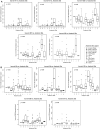A comprehensive study of smoking-specific microRNA alterations in head and neck squamous cell carcinoma
- PMID: 28797462
- PMCID: PMC5555648
- DOI: 10.1016/j.oraloncology.2017.07.009
A comprehensive study of smoking-specific microRNA alterations in head and neck squamous cell carcinoma
Abstract
Objective: While tobacco smoking is a well-known risk factor for head and neck squamous cell carcinoma (HNSCC), the molecular mechanisms underlying tobacco-induced HNSCC remain unclear. This study sought to comprehensively identify microRNA (miRNA) alterations and evaluate their clinical relevance in smoking-induced HNSCC pathogenesis and progression.
Materials and methods: Using small RNA-sequencing data and clinical data from 145 HNSCC patients, we performed a series of differential expression and correlation analyses to identify a panel of tobacco-dysregulated miRNAs associated with key clinical characteristics in HNSCC. We then examined the expression patterns of these miRNAs in normal epithelial cell lines following exposure to cigarette smoke extract.
Results: Our analyses revealed distinct panels of miRNAs to be dysregulated with smoking status and associated with additional clinical features, including tumor stage, metastasis, anatomic site, and patient survival. The differential expression of key miRNAs, including miR-101, miR-181b, miR-486, and miR-1301, was verified in cigarette-treated epithelial cell lines, suggesting their potential roles in the early development of smoking-related HNSCCs.
Conclusion: Specific alterations in miRNA expression may be traced to tobacco use and are associated with important HNSCC clinical characteristics. Future studies of these miRNAs may be valuable for furthering the understanding and targeted treatment of smoking-associated HNSCC.
Keywords: Head and neck neoplasms; MicroRNAs; RNA, Untranslated; Smoking.
Copyright © 2017 Elsevier Ltd. All rights reserved.
Conflict of interest statement
Figures






Similar articles
-
Alcohol-dysregulated miR-30a and miR-934 in head and neck squamous cell carcinoma.Mol Cancer. 2015 Oct 15;14:181. doi: 10.1186/s12943-015-0452-8. Mol Cancer. 2015. PMID: 26472042 Free PMC article.
-
Deep sequencing-based microRNA expression signatures in head and neck squamous cell carcinoma: dual strands of pre-miR-150 as antitumor miRNAs.Oncotarget. 2017 May 2;8(18):30288-30304. doi: 10.18632/oncotarget.16327. Oncotarget. 2017. PMID: 28415821 Free PMC article.
-
Antitumor miR-150-5p and miR-150-3p inhibit cancer cell aggressiveness by targeting SPOCK1 in head and neck squamous cell carcinoma.Auris Nasus Larynx. 2018 Aug;45(4):854-865. doi: 10.1016/j.anl.2017.11.019. Epub 2017 Dec 9. Auris Nasus Larynx. 2018. PMID: 29233721
-
miRNAs in head and neck cancer revisited.Cell Oncol (Dordr). 2013 Feb;36(1):1-7. doi: 10.1007/s13402-012-0122-4. Epub 2013 Jan 22. Cell Oncol (Dordr). 2013. PMID: 23338821 Review.
-
The microRNA signatures: aberrantly expressed microRNAs in head and neck squamous cell carcinoma.J Hum Genet. 2017 Jan;62(1):3-13. doi: 10.1038/jhg.2016.105. Epub 2016 Aug 25. J Hum Genet. 2017. PMID: 27557665 Review.
Cited by
-
MicroRNA and mRNA Interaction Network Regulates the Malignant Transformation of Human Bronchial Epithelial Cells Induced by Cigarette Smoke.Front Oncol. 2019 Oct 9;9:1029. doi: 10.3389/fonc.2019.01029. eCollection 2019. Front Oncol. 2019. PMID: 31649886 Free PMC article.
-
A plasma miRNA-based classifier for small cell lung cancer diagnosis.Front Oncol. 2023 Oct 5;13:1255527. doi: 10.3389/fonc.2023.1255527. eCollection 2023. Front Oncol. 2023. PMID: 37869089 Free PMC article.
-
Insight toward the MicroRNA Profiling of Laryngeal Cancers: Biological Role and Clinical Impact.Int J Mol Sci. 2020 May 24;21(10):3693. doi: 10.3390/ijms21103693. Int J Mol Sci. 2020. PMID: 32456271 Free PMC article. Review.
-
Emerging paradigms: unmasking the role of oxidative stress in HPV-induced carcinogenesis.Infect Agent Cancer. 2024 Jul 2;19(1):30. doi: 10.1186/s13027-024-00581-8. Infect Agent Cancer. 2024. PMID: 38956668 Free PMC article. Review.
-
Noncoding RNome as Enabling Biomarkers for Precision Health.Int J Mol Sci. 2022 Sep 8;23(18):10390. doi: 10.3390/ijms231810390. Int J Mol Sci. 2022. PMID: 36142304 Free PMC article. Review.
References
-
- Jemal A, Bray F, Center MM, Ferlay J, Ward E, Forman D. Global cancer statistics. CA Cancer JClin. 2011;61:69–90. - PubMed
-
- Braakhuis BJ, Leemans CR, Brakenhoff RH. Expanding fields of genetically altered cells in head and neck squamous carcinogenesis. Semin Cancer Biol. 2005;15:113–20. - PubMed
-
- Hashibe M, Brennan P, Chuang SC, Boccia S, Castellsague X, Chen C, et al. Interaction between tobacco and alcohol use and the risk of head and neck cancer: pooled analysis in the International Head and Neck Cancer Epidemiology Consortium. Cancer Epidemiol Biomarkers Prev. 2009;18:541–50. - PMC - PubMed
Publication types
MeSH terms
Substances
Grants and funding
LinkOut - more resources
Full Text Sources
Other Literature Sources
Medical

